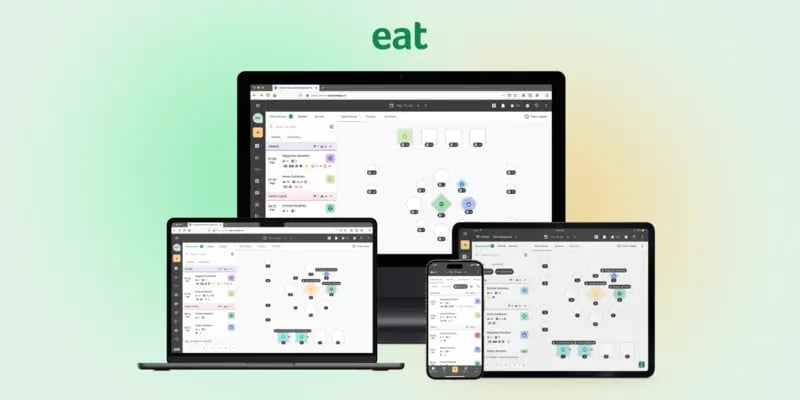Looking for a better reservation system than Tablein? Whether you're managing a bustling bistro or an upscale dining room, choosing the right booking platform can make all the difference.
While Tablein is popular for its simplicity and affordability, it may not check every box for growing or tech-forward restaurants. From flexible pricing to deeper guest insights, plenty of Tablein alternatives offer powerful features that help streamline operations and improve the guest experience. In this guide, we break down the top competitors and similar platforms to help you find the perfect fit.
Key Takeaways
-
Eat App: A flexible, user-friendly Tablein alternative that offers a feature-rich platform (from free to premium plans) for restaurants of all sizes without per-cover fees.
-
OpenTable: A popular Tablein competitor known for its extensive diner network and advanced tools, though it comes at a higher cost (monthly fees plus cover charges).
-
Other Alternatives: Competitors and similar websites to Tablein (like Resy, SevenRooms, and more) provide unique features from free basic plans to integrated POS solutions catering to different restaurant types and budgets.
Top Tablein alternatives for restaurants
Below is a list of the top Tablein alternatives and competitors that can streamline reservations and table management. Each option is an analog to Tablein with its own advantages. Let’s dive into the details of each site like Tablein:
Eat App

Eat App is a top-rated reservation and table management platform that helps restaurants increase efficiency and revenue through real-time bookings, automation & guest data management. As a Tablein alternative, Eat App stands out for its comprehensive feature set and flexible pricing. Eat App does not charge per-cover fees, making it a cost-effective choice for growing businesses.
Key features include:
- Real-time table & waitlist management with an interactive floor plan
- Built-in communication tools (two-way WhatsApp messaging, SMS & email notifications) for confirmations and feedback
- A robust guest database & CRM for personalized service and marketing (loyalty programs, automated campaigns)
- 24/7 support and onboarding assistance for smooth implementation
This modern platform is used by thousands of restaurants in 70+ countries, from independent bistros to large hotel chains. It’s ideal for operators seeking to optimize guest experience and operations, whether you’re upgrading from pen-and-paper or replacing another system.
Takeaway: Eat App is a powerful yet user-friendly solution with a generous free plan and tiered pricing making it a compelling first choice if you want an all-in-one system without high costs per booking.
Pricing Plans include
- Free Plan – $0/month: Includes up to 30 covers each month
- Starter Plan – $69/month: Includes up to 300 covers per month
- Basic Plan – $139/month: Unlimited covers every month
- Pro Plan – $239/month: Access to the full suite of guest experience tools
Take a look at the pricing plans here.
Further reading
OpenTable

OpenTable is one of the most well-known names in restaurant reservations, often considered a default choice. As a Tablein alternative, OpenTable’s biggest advantage is its extensive diner network – millions of users use OpenTable’s website and app to discover and book restaurants.
This can significantly boost your exposure and help fill seats, especially if attracting new diners is a priority. OpenTable provides powerful features such as customizable floor plans, waitlist management, automated email marketing, and integrations with 100+ partner platforms for visibility.
However, these benefits come with a higher price tag. OpenTable operates on a subscription model with tiered plans:
- Basic Plan – $39/month
Includes a charge of $1.50 per cover booked through the OpenTable network and $0.25 per cover via the booking widget. - Core Plan – $249/month
Includes a fee of $1 per cover booked through the OpenTable network. - Pro Plan – $449/month
Also includes a fee of $1 per cover booked through the OpenTable network.
Takeaway: OpenTable is an industry leader with unmatched reach to potential guests, making it a strong site like Tablein for marketing exposure. But smaller restaurants may find the costs (monthly fees + cover charges) hard to justify, especially when commission-free options like Eat App exist.
Resy

Resy (also known as Resy OS) has quickly grown into a major reservation platform and is often mentioned among top Tablein alternatives. Backed by American Express, Resy is used by a wide range of venues from neighborhood eateries to Michelin starred restaurants. It offers a sleek, modern interface for managing reservations, waitlists and guest profiles. A notable benefit is that Resy does not charge per-cover fees for reservations which means you won’t be penalized for being busy. Instead, Resy has straightforward monthly pricing (plans typically start around $249/mo for the basic platform package and go up for more advanced tiers with additional features or support).
Resy’s feature set includes table management tools, a robust guest database with shared profiles across restaurants & integrations with platforms like Instagram and Google that allow customers to book directly through those channels. This omnichannel approach helps restaurants capture bookings from multiple sources. Restaurants also appreciate Resy’s focus on hospitality, for example, sharing guest notes (like dietary preferences or VIP status) across all devices to personalize service.
Takeaway: Resy is a strong competitor with a user-friendly app & no commission fees. It’s a great analog to Tablein for restaurants that want a polished system and are willing to invest in a monthly plan for access to Resy’s tech-savvy diner base, especially in the U.S. market.
SevenRooms

Sevenrooms is an all-in-one hospitality platform known for its advanced guest management and marketing capabilities. As a Tablein competitor, SevenRooms differentiates itself by offering commission-free online reservations (no per-cover fees) and by capturing rich guest data that restaurants can use for personalized service. It integrates with popular channels like Google, Facebook and Instagram for reservations, expanding your reach to new guests. SevenRooms is also multilingual and supports various policies like deposits and credit card holds to reduce no-shows – features that high-demand venues find valuable.
One of Sevenrooms strongest points is its CRM and automated marketing. The system builds detailed guest profiles (e.g, dining preferences, birthdays, visit history) and enables customized email campaigns or loyalty rewards based on that data. This helps improve customer engagement and repeat visits. Many large restaurant groups and luxury hospitality brands use SevenRooms for its enterprise-grade tools. On the flip side, SevenRooms can be complex to navigate at first, and its pricing is on the higher end (often quote-based, with premium support packages ranging from ~$149 up to $799/month for dedicated account management).
Takeaway: Sevenrooms is a powerful site similar to Tablein for restaurants that want to leverage data-driven marketing and don’t mind a steeper learning curve. It’s an excellent choice for upscale venues or groups that need deep CRM functionality though smaller restaurants might find it more than they need.
Tock

Tock is a reservation system that gained fame for its unique approach to bookings allowing restaurants to take deposits or sell prepaid tickets for dining experiences. If your restaurant offers tasting menus, ticketed events or just wants to reduce no-shows with credit card holds, Tock can be an attractive Tablein alternative. The platform supports standard reservations and waitlists alongside these prepaid experiences giving it a flexible edge. Restaurants use Tock to require a deposit for high-demand nights or to sell tickets for special events which has been proven to drastically cut no-show rates.
Tock’s pricing is relatively straightforward; it has a few tiers (reported starting around $99/month for a base plan, up to around $300+ for premium plans) and typically charges a small percentage (2–3%) on any prepaid reservations or tickets sold. Notably, Tock does not charge per diner for free reservations (no cover fees), which can mean cost savings compared to systems that do. The user interface is modern and geared towards both fine-dining and casual spots, and since being acquired by Squarespace, Tock has expanded its support and integrations.
Takeaway: Tock is a great analog to Tablein for restaurants that want flexibility in how they take bookings, especially if you plan to offer paid experiences or need deposit features. It provides robust table management plus revenue-generating tools, though it’s most beneficial if you use its unique prepaid features.
Yelp Guest Manager

Yelp Guest Manager (formerly known as Yelp Reservations and NoWait) combines online reservations with waitlist management, leveraging the vast user base of Yelp. For restaurants, especially in North America that get a lot of traffic from Yelp listings, this system can be a valuable Tablein alternative. With Yelp Guest Manager, your restaurant’s Yelp page features a “Reserve” or “Join Waitlist” button funneling interested diners directly into your booking system. This built-in marketing is a key advantage you tap into diners who are actively searching for places to eat.
The platform itself offers standard features, A cloud-based reservation book, real-time updates on table status, text notifications to guests when their table is ready and basic customer info tracking. It’s designed to be easy for staff to use on a tablet, and it merges waitlist and reservations so you can manage walk-ins alongside bookings seamlessly. Pricing for Yelp Guest Manager is generally a flat monthly fee (plans have started around $119–$249/month, depending on features and restaurant size). There are no per-cover fees, which is a plus for busy casual eateries.
Takeaway: Yelp Guest Manager is an attractive site like Tablein for restaurants that rely on Yelp for visibility or need a simple combined waitlist/reservation solution. It may not have all the advanced CRM bells and whistles of some competitors like Eat App, but it excels in boosting online discovery and is fairly budget-friendly.
Further reading
ResDiary

ResDiary is a long established reservation system (originating in the UK) that offers a solid suite of features without per-cover fees.It’s often considered when looking at Tablein alternatives, particularly for restaurants in Europe, Asia, or Australia.ResDiary provides all the core tools: online booking widgets, table management, an event booking module & a built-in CRM for capturing guest details. A standout feature is ResPhone, an automated phone reservation system that answers calls and turns them into bookings. This can save time and reduce missed reservations from phone inquiries.ResDiary also integrates with Dish Cult, a consumer-facing reservations marketplace, giving your restaurant extra online exposure.
To help minimize no-shows, ResDiary sends automated email/SMS reminders to guests and can secure credit card details or deposits for reservations (a useful option for busy nights). The pricing is typically flat monthly subscriptions based on package level, for e.g:
ResDiary Pricing Plans
- Connect Plan – €99/month
- Express Plan – €129/month
- Pro Plan – €189/month
- Ultimate Plan – €289/month
Takeaway: ResDiary is a feature-rich Tablein competitor that appeals to restaurants wanting predictable costs and strong operational tools. It’s a particularly popular Tablein alternative in markets like the UK and Europe. While it may not have the ultra-modern interface of newer startups, it’s reliable and continually improving with useful integrations.
Quandoo

Quandoo is a web-based reservation management solution that doubles as a diner marketplace, primarily active across Europe and the Asia-Pacific region. It’s worth considering as a Tablein alternative if your restaurant is in one of Quandoo’s strong markets and you want to boost online discovery. The system offers the essentials for managing bookings, customizable online widgets, social media integration for reservations, basic table and capacity management & analytics/reporting to track your bookings. One clever feature is its ability to predict wait times for walk-ins or waitlisted guests using AI, which can help improve the guest experience and turnover.
Quandoo’s diner-facing platform can list your restaurant for customers browsing the Quandoo app/website (similar to how OpenTable or Yelp’s platforms work), potentially driving new customers. However, note that Quandoo’s in-house features are somewhat limited compared to larger competitors; it lacks built-in email marketing, CRM beyond basic guest info or extras like online ordering. Pricing comes in two tiers, for example, a Pro plan around £39/month & a Premium plan around £99/month, each with a one-time setup fee. Additionally, Quandoo charges a commission (~£3.90 per cover) for reservations that originate from their own marketplace/app, though bookings made via your own website or social channels are fee-free.
Takeaway: Quandoo can be a useful hybrid solution, a simple reservation management tool plus a marketing marketplace for restaurants in its network. It’s a decent analog to Tablein if you operate in Europe or APAC and want extra visibility, but be sure to factor in the commission fees on marketplace bookings when evaluating the cost.
TouchBistro
.png?width=642&height=379&name=Touchbistro-642x379-H%20(1).png)
TouchBistro Reservations is part of the TouchBistro suite, an iPad-based POS system popular in the restaurant industry. This option is a bit different from others on the list because it’s tightly integrated with point-of-sale, which can be a major plus if you’re aiming for an all-in-one technology stack. As a Tablein alternative, TouchBistro offers standard reservation and table management features similar to Tablein (online bookings, floor plan, guest notes), but the real benefit comes when you use it alongside TouchBistro’s POS, your reservation system, and the POS share data. For example, a guest’s past orders or spend can be tied to their reservation profile, or you can see live table statuses from the dining room and update them as bills are closed. This integration can streamline operations and reporting across your restaurant.
TouchBistro Reservations operates on a subscription model. Keep in mind that TouchBistro is built for iPad, so you’ll need an iOS device to run it optimally. Its coverage is also mostly in North America and a few other English-speaking markets, as some features might not be active globally.
TouchBistro POS Pricing Plans
- Solo Plan: $69/month for 1 license
- Dual Plan: $129/month for 2 licenses
- Team Plan: $249/month for up to 5 licenses
- Unlimited Plan: $399/month for unlimited licenses
Takeaway: If you’re looking to unify your reservations with your POS and prefer a single vendor, TouchBistro is a strong Tablein alternative. It’s especially useful for restaurants that are already on TouchBistro POS or plan to be, as it can centralize your operations. For purely reservation-focused needs, other dedicated platforms might offer more marketing tools or global reach, but TouchBistro’s integrated approach is hard to beat for operational efficiency.
Choosing the right Tablein alternative
Selecting the best restaurant reservation platform comes down to your restaurant’s priorities. Each Tablein alternative we’ve covered excels in different areas: Eat App offers an all-around robust solution with flexible pricing; OpenTable provides unmatched access to diners but at a premium, Resy & SevenRooms focus on no-cover-fee models and rich guest data; others like ResDiary, Quandoo , or Yelp Guest Manager cater to specific markets or niches. Consider the following when making your decision:
- Budget: Factor in not just monthly subscription costs but also any per-user fees or setup fees. A tool with a slightly higher flat monthly rate might save you money if it avoids commission fees that add up.
- Feature Needs: Identify the features most important to you. Do you need waitlist management, automated marketing emails, or multi-language support? Perhaps having a similar site to Tablein with integrated POS or loyalty programs is a priority.
- Ease of Use: A system is only valuable if your team will use it effectively. Consider running a trial of the top contenders to gauge which interface is most intuitive for you and your staff.
- Support and Scalability: Look at the level of customer support (email, phone, 24/7) and whether the platform can grow with you. If you plan to expand or have complex operations, ensure the software can handle additional locations or higher volume.
Ultimately, the right choice is the one that fits your restaurant’s workflow and helps you provide great hospitality without breaking the bank. By exploring these Tablein competitors, you’re already on the right track – doing your due diligence. With the ideal reservation system in place, you can streamline operations, reduce no-shows, fill more tables, and focus on delivering a memorable dining experience to every guest. Good luck, and happy booking!














.webp?width=200&name=v2-15mknc-qpw1b%20(1).webp)
.webp?width=200&name=v2-15kqni-p0exl%20(1).webp)
-1.png?width=1812&height=1072&name=TripAdvisor%20%26%20More%20Bookings%20(1)-1.png)
-2.png?width=1812&height=1072&name=Google%20Bookings%20(1)-2.png)


-1.png?width=200&name=TripAdvisor%20%26%20More%20Bookings%20(1)-1.png)
-2.png?width=200&name=Google%20Bookings%20(1)-2.png)
-1.png?width=200&name=Instagram%20Bookings%20(1)-1.png)
-1-png.webp?width=200&name=Facebook%20Integration%20Rectangle%20(1)-1-png.webp)







.webp?width=200&name=download%20(1).webp)
%20(1)-2.webp?width=200&name=Eat%20(34)%20(1)-2.webp)
%20(1)-2.webp?width=200&name=Eat%20(18)%20(1)-2.webp)




.png?width=670&height=440&name=Untitled%20design%20(7).png)



.webp?width=314&height=175&name=Frame%202608526%20(1).webp)


.webp?width=144&height=72&name=Eat%20App%20Logo%20(3).webp)